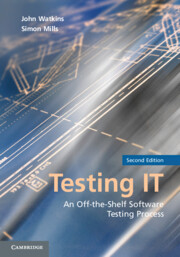Book contents
- Frontmatter
- Contents
- Foreword to the Second Edition by Geoff Thompson
- Foreword to the First Edition by Maurice Rosenburgh
- Acknowledgments
- 1 Introduction
- PART 1 THE TRADITIONAL TESTING PROCESS
- PART 2 THE TESTING PROCESS IN THE REAL WORLD: ILLUSTRATIVE CASE STUDIES
- PART 3 THE APPENDICES
- Appendix A Terms of Reference for Testing Staff
- Appendix B Testing Guides
- Appendix C Test Plan Document Template
- Appendix D Test Specification Document Template
- Appendix E Test Script Template
- Appendix F Test Result Record Form Template
- Appendix G Test Log Template
- Appendix H Test Certificate Template
- Appendix I Reuse Pack Checklist
- Appendix J Test Summary Report Template
- Appendix K Equivalence Partition Example
- Appendix L Boundary Value Analysis Example
- Appendix M State Transition Example
- Appendix N Pairwise Testing Example
- Appendix O Automated Testing Tool Selection Criteria
- Appendix P Usability Testing Overview
- Appendix Q Testing Process Health Check
- Appendix R The Testing of Object-Oriented Software
- Appendix S Pragmatic Test Process Adoption – a Real-World Example
- References
- Glossary
- Index
Appendix Q - Testing Process Health Check
Published online by Cambridge University Press: 03 May 2011
- Frontmatter
- Contents
- Foreword to the Second Edition by Geoff Thompson
- Foreword to the First Edition by Maurice Rosenburgh
- Acknowledgments
- 1 Introduction
- PART 1 THE TRADITIONAL TESTING PROCESS
- PART 2 THE TESTING PROCESS IN THE REAL WORLD: ILLUSTRATIVE CASE STUDIES
- PART 3 THE APPENDICES
- Appendix A Terms of Reference for Testing Staff
- Appendix B Testing Guides
- Appendix C Test Plan Document Template
- Appendix D Test Specification Document Template
- Appendix E Test Script Template
- Appendix F Test Result Record Form Template
- Appendix G Test Log Template
- Appendix H Test Certificate Template
- Appendix I Reuse Pack Checklist
- Appendix J Test Summary Report Template
- Appendix K Equivalence Partition Example
- Appendix L Boundary Value Analysis Example
- Appendix M State Transition Example
- Appendix N Pairwise Testing Example
- Appendix O Automated Testing Tool Selection Criteria
- Appendix P Usability Testing Overview
- Appendix Q Testing Process Health Check
- Appendix R The Testing of Object-Oriented Software
- Appendix S Pragmatic Test Process Adoption – a Real-World Example
- References
- Glossary
- Index
Summary
Introduction
This appendix contains a list of criteria to be used in performing a testing process health check and a suggested approach to conducting the task.
The testing process health check could be used in a number of ways:
To baseline the current state of testing within an organization prior to introducing a formal testing process
To monitor the progress of the adoption of a formal testing process, and to identify areas that were satisfactory and areas capable of improvement
As part of a process improvement program (see Chapter 13 – Improving the Testing Process).
The criteria used in the testing process health check are grouped under the following high-level headings:
Testing and the software development process
Testing process
Roles and responsibilities
Testing phases.
These groups and their individual criteria are described in full in the following sections respectively. Section Q7 contains an optional scheme for scoring the various criteria if a more quantitative approach is required.
A checklist is provided at the end of this appendix that can be copied and used as an aide-memoir during the testing process health check. This checklist is also available to download using the following link: http://www.cambridge.org/9780521148016/.
Terminology
The term “subject” is used to denote the person, project, department, or organization that is the target of the testing process health check. The term subject could refer to a third-party organization whose testing process needs to be assessed, or internally within the host organization.
- Type
- Chapter
- Information
- Testing ITAn Off-the-Shelf Software Testing Process, pp. 292 - 297Publisher: Cambridge University PressPrint publication year: 2010



